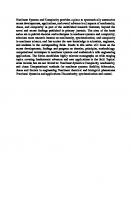Revisiting McKeithen Weeden Island: Complexity, Ritual, and Pottery (Archaeology of the American South: New Directions and Perspectives) 0817321756, 9780817321758
Reassesses the ancient Indigenous McKeithen site in northern Florida in light of new data, analyses, and theories Revis
118 20 3MB
English Pages 132 Year 2023
Recommend Papers

- Author / Uploaded
- Prudence M. Rice
File loading please wait...
Citation preview
[128.104.46.196] Project MUSE (2024-04-09 03:49 GMT) UW-Madison Libraries
!"#$%$&$'()*+), "$&-"').""/"')$%01'/
!"#$%&'(')*+',+-$&+!.&"/#%0+1'2-$3++ 4&5+6/"&#-/'07+%08+9&"7:&#-/;&7 1&"/&7+%@(&7 1.1. South-to-north Bayesian migration model of Weeden Island interior settlement from the Gulf Coast 22 1.2. Calibrated conventional and new radiocarbon ages and dates (AD) from the McKeithen mounds
25
1.3. Conventional and calibrated radiocarbon dates (AD) from the McKeithen village
27
2.1. Michael Mann’s concepts of ideological power in different societal scales 3.1. Stamped pottery occurrences at McKeithen
46
3.2. Weeden Island subregions and number of pottery thin sections analyzed from each
53
3.3. Proposed manufacturing subregions of 248 Weeden Island (WI) series prestige/ritual ceramics from petrographic data, by type
54
3.4. Provisional local vs. nonlocal origins of 20 Weeden Island series (plus two unidentified) pottery objects at McKeithen Mounds B and C, based on petrography and neutron activation analysis (NAA) 4.1. Excavated burial population from McKeithen Mound C
72
56
32
9ECB4
Weeden Island, originally identified as a time period, was divided into two subperiods: Early or Weeden Island I (AD 200/300–700/750) and Late or Weeden Island II (AD 700/750–900/1000) (Willey 1949:396–452. Milanich [2002:354– 355, Figure 16.2] begins McKeithen Weeden Island at AD 100). This chronology was based on sites and pottery along the Florida Gulf Coast, especially in northwest (panhandle) Florida. As more sites were excavated, however, problems of dating Weeden Island were increasingly recognized, with better stratigraphy noted in middens rather than in mounds along the coast (Willey 1949:190). More recently, attention has been drawn to significant difficulties concerning the spatiotemporal relations between Weeden Island and Swift Creek culture. Swift Creek is a late Middle and Late Woodland–period (AD 200–1000) archaeological culture centered on what is now the state of Georgia and immediately adjacent areas, including much of northern Florida and the panhandle, and most of eastern and southern Alabama. These adjacent areas or “borderlands” (Lolley 2003) at the southern margins of Swift Creek are, of course, the region occupied by Weeden Islanders (Figure 1.1). Chronological problems have proved to be particularly intractable in one portion of this spatial overlap: northwestern Florida and southwestern Georgia/Alabama, which together exhibit significant contrasts with northern (mainland) Florida (Milanich et al. 1984:14, 40). An attempt at more refined dating for Northwest Florida Weeden Island was offered 50 years ago by George Percy and David Brose (1974), who proposed
20 Chapter 1
Figure 1.1. Swift Creek region of Georgia and adjacent areas (solid line) in the lower Southeast, with the distribution of Weeden Island sites (dotted line) in its southern portion. (Map by Don Rice.)
five chronological subdivisions. Their partitions were based in part on relations with Swift Creek and on identifying a “Wakulla period” through the presence of Wakulla Check-Stamped pottery (only nine sherds of which were identified at McKeithen). More recently, the Woodland-period chronology of this area has undergone revision, with a focus on sites in the lower Chattahoochee/Apalachicola River valley. Efforts were directed primarily toward better dating of Kolomoki in southwest Georgia and better understanding of relations between the two cultures, Weeden Island and Swift Creek. A proposed new sequence
Complexification, Migration, and Dating
21
combines Bayesian modeling of old (conventional) and new (AMS; calibrated) radiocarbon dates from Kolomoki, McKeithen, and other sites in the region (Pluckhahn et al. 2020). Kolomoki and other western sites are now primarily identified with Swift Creek during the Middle and Late Woodland periods (Pluckhahn et al. 2018, 2020; see also Smith 2009:14; Smith and Stephenson 2018:12). Weeden Island appears late in the west, beginning with in-migration around AD 700 or so. At Kolomoki, distinctive Swift Creek pottery—with complex impressed designs known as complicated-stamped (see Chapter 3)— dominated until around cal AD 750, at which point there was “an abrupt transition” and a “relatively sudden increase” in late Weeden Island types (Pluckhahn et al. 2018:327). In addition, the key Weeden Island mortuary practices— secondary bundle and single skull burials, and deposits of pottery at the sides of tumuli—were introduced considerably later than originally thought. The deposit at Kolomoki Mound D had a mix of Swift Creek and Weeden Island pottery types and was dated between cal AD 570 and 655, but possibly as late as 870 (Pluckhahn et al. 2018:334). The dynamics of the new chronology center on migration: movements of mobile, mound-building groups from the Florida Gulf Coast northward and into the interior, beginning around cal AD 30–220 (p = 95%; Pluckhahn et al. 2020). Migration, once a taboo topic in Americanist archaeology, is now of considerable interest and furthered by more precise (calibrated) dating systems and Bayesian modeling. These procedures facilitated development of a model of settlement growth in the deep Southeast, including Weeden Island sites, which proceeded from Regional Phase 1 and a “village formation phase” with variable beginnings around cal AD 30/220 and lasting to cal AD 360/615 (Table 1.1) (Pluckhahn et al. 2020:476). In the proposed scenario, over several centuries the emigrants—apparently initially peoples of the coastal Deptford culture—established new, sedentary villages, ushering in a period of growth and expansion. The cause(s) of these migrations have been variously attributed, in whole or in part, to late Middle Woodland adoption of maize agriculture (e.g., Percy and Brose 1974:19–21), to a pulse in sea level change (Pluckhahn et al. 2020:478, 483; Pluckhahn et al. 2022), or to three multidecade episodes of extended reduced rainfall or drought in the Middle to Late Woodland periods in the west (Smith 2009:156, 173–176). The episodes of lower rainfall on the Chattahoochee/Apalachicola coast of the Florida panhandle are dated cal AD 388–420, 659–724, and 811–891 (Smith 2009:156). A role for demographic pressure is unclear: the coastal zone is relatively narrow (~16 km wide) and populations might have had to compete for access to the most productive areas, such as shellfish beds or fish runs (Milanich 2002:368). To the east, inland Weeden Island sites are commonly located near streams and upper tributaries of major river courses through the
Regional village formation
Expansion of southern villages
Contraction of southern villages
First expansion of northern villages
Second expansion of northern villages
WI village reorganization
1
2
3
4
5
6
740/865 to 905/957
612/643 to 717/781
580/630 to 670–699
499/621 to 678/807
245/316 to 455/541
114/202 to 421/526
Dates 68% prob., Calibrated ADa
WI pottery more common in villages
Gap in dates between north and south = migration
Weeden Island (WI) General
Settlement in southern arm of village
Mound C cache, 663/770 TPQ
(Re)organization into U-shaped village?
Construction of mounds and village
First and early second centuries; posts and firepit in area of Mound A
McKeithen
a Substantial overlapping, especially of modeled ending dates of phases, is seen between most phases, even in the 1σ (68% probability) dates given here, but especially in the 2σ dates with 95% probability.
Note: Data from Pluckhahn et al. 2020:475–486; probabilities from Pluckhahn et al. 2020:Table 3. TPQ = terminus post quem (“date after which” or possible earliest date).
Events
Phase
>!=DIO>BO4BE>I+=!LCB4+KB6I!K9>+AECB41+!4!DLZ?EC4H+1?=E


![American Antiquities: Revisiting the Origins of American Archaeology [1 ed.]
9780803284319, 9780803268425](https://ebin.pub/img/200x200/american-antiquities-revisiting-the-origins-of-american-archaeology-1nbsped-9780803284319-9780803268425.jpg)






